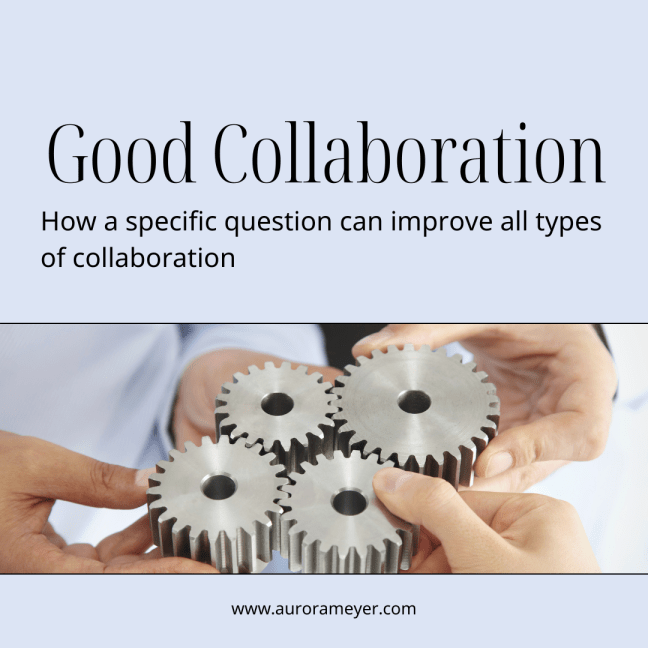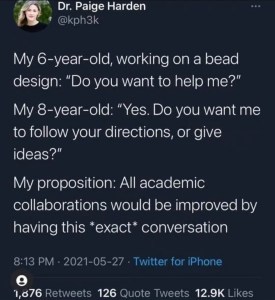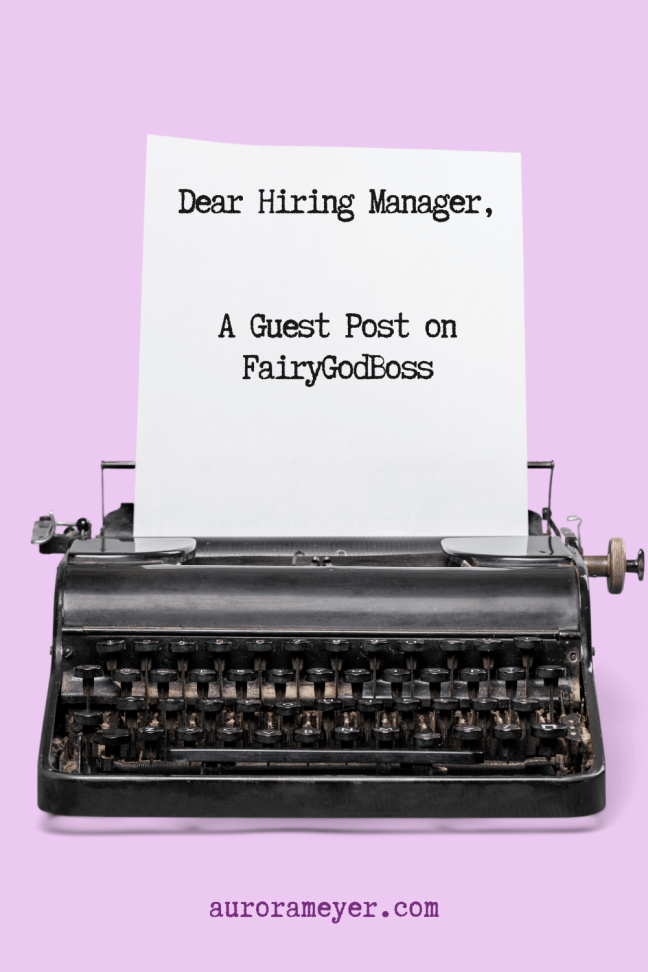Choosing between giving direction or sharing ideas might not always be as binary as it seems, and that’s precisely where the magic of collaboration comes into play. A 2021, Tweet from Dr. Paige Harden @kpd3k, shared how observing her children asking two questions could vastly improve collaborations.
Collaboration is more than just working together. Good collaboration is about harnessing the collective power of diverse minds and perspectives to achieve something greater. I strongly believe everyone needs an editor, but I also strongly believe everyone needs a supportive collaborator. I’m lucky to have found such a person in Liz who is one of the best people to think through ideas with because she often uses, “yes, and.” There’s magic in those words.
Defining Collaboration
Collaboration is the art of teamwork and shared effort. It’s the process of combining individual strengths, ideas, and resources to achieve a common goal or solve a problem. Good collaboration isn’t just about coming together; it’s about truly working together toward a common goal or objective. It’s about those moments when the whole becomes greater than the sum of the ideas, contributions, tactics and initiatives.
Collaboration thrives on communication, openness, and the willingness to listen, not ego or ownership. Environments where hierarchy and turf wars reign are not conducive to collaboration. Ultimately, collaboration needs an environment where everyone’s ideas and input are valued and starts with really meaning it when someone says at this point there are no bad ideas. Diverse perspectives can bring about innovation and creativity that might not have been possible otherwise.
Why Collaboration Matters
Collaboration matters, not only because it leads to better outcomes, but because it enhances our work and if done well, leaves everyone feeling valued. Each person brings a unique perspective to the table. When we collaborate, we tap into this diversity, which can lead to more comprehensive problem-solving and innovative ideas. Collaboration provides an opportunity to learn from others. It’s a chance to expand your knowledge and skill set by working with people who possess different expertise and experiences. We are not suggesting the work should be done by committee, or that the end product is up for a vote, this is more about working together with the end goal in mind.
Improved Decision-Making
Collaborative decision-making often results in more robust, well-informed choices. It allows for a thorough exploration of options and potential consequences. To reiterate, collaboration could be coming up with a theme or phrasing between two people. It could be a small group brainstorming ideas for attaining a specific goal or working together for a specific project. You’ll know when you’ve gathered enough input for the best results. You’ll also know who to include in the future and who to bring in for other times. Everyone on your team has a strength.
Strengthened Relationships
Working closely with others fosters a sense of connection and camaraderie. Good collaboration can improve teamwork, trust, and overall workplace satisfaction. In many cases, dividing tasks and responsibilities among a group of people can expedite the overall processes. When you leverage each other’s strengths, tasks are completed more efficiently, and each person is vested in the outcomes.
The Collaborative Spectrum
Collaboration isn’t one-size-fits-all. It spans a spectrum of approaches, from structured and directive to open and organic. Some of the most common forms are:
- Directed Collaboration: This approach is guided by a clear leader or organizer who sets the direction and assigns tasks. It’s effective in situations where a specific goal needs to be achieved efficiently.
- Participative Collaboration: Here, team members actively contribute their ideas and opinions. It’s a democratic process where everyone has a say, leading to more inclusive decision-making.
- Co-Creative Collaboration: This is the most open and organic form of collaboration. It involves creative brainstorming and innovation where the entire group contributes to shaping the final outcome. It’s often used in design thinking and innovation projects.
The choice of which mode to adopt depends on the nature of the task, the group’s dynamics, and the desired outcome. Sometimes, a combination of these approaches may yield the best results. The goal is not to water down the project by working as a committee, the goal is to let the best ideas surface.
Collaboration in Practice
In the workplace, collaboration is often encouraged because of its potential to drive success. Teams can pool their strengths and expertise, whether it’s for a creative project, problem-solving, or achieving a shared goal. Effective collaboration requires many of the skills necessary for good relationships in general such as active listening, open communication, and a willingness to embrace and respect diverse perspectives. Technology has transformed collaboration, making it possible to work together across distances and time zones. Virtual collaboration tools, project management software, and video conferencing have broken down geographical barriers, allowing people to collaborate seamlessly regardless of location.
Overcoming Collaboration Challenges
While collaboration is a powerful force, it’s not without its challenges. One common issue is the clash of personalities and ideas. Disagreements can be healthy, but they need to be managed constructively and a good leader should be able to diffuse situations before they become detrimental to the intended outcome or the overall working relationship. Collaboration should bring people and teams together, not make them frustrated or tear them apart. Another challenge is ensuring that everyone’s voice is heard. In larger groups, some individuals may feel overshadowed, leading to a lack of engagement. It’s the responsibility of team leaders and members to ensure inclusivity and active participation. Just because someone is the loudest voice, doesn’t mean their ideas are better.
Collaboration is a fundamental concept that has the potential to transform the way teams and departments and organizations work and interact. Good collaboration blends individual strengths and perspectives.






